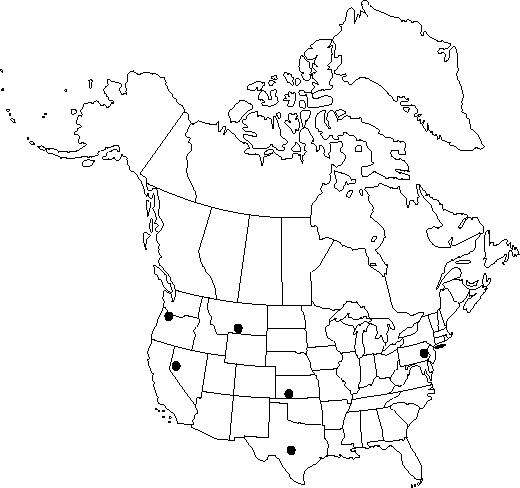Difference between revisions of "Glaucium corniculatum"
Fl. Jen., 13. 1781.
FNA>Volume Importer |
FNA>Volume Importer |
||
| Line 26: | Line 26: | ||
}}<!-- | }}<!-- | ||
| − | --><span class="statement" id="st- | + | --><span class="statement" id="st-undefined" data-properties=""><b>Plants </b>annual or occasionally biennial, to 5 dm. <b>Stems</b> branching. <b>Leaves</b> to 25 cm; basal few, blade glabrate to moderately pubescent; basal and proximal cauline with blade lyrate, 7-9-lobed; distal with blade ovate, not distinctly clasping stem (sometimes slightly cordate-clasping); margins deeply dentate. <b>Flowers</b>: pedicels stout, to 5 cm; sepals 15-30 mm; petals orange to reddish orange, usually with blackish basal spot, obovate, to 40 mm. <b>Capsules</b> sublinear, straight or slightly curved, to 25 cm, appressed- to ascending-pubescent or glabrate.</span><!-- |
-->{{Treatment/Body | -->{{Treatment/Body | ||
| Line 32: | Line 32: | ||
|habitat=Open shores, fields, pastures, and canyon slopes | |habitat=Open shores, fields, pastures, and canyon slopes | ||
|elevation=0-1600 m | |elevation=0-1600 m | ||
| − | |distribution=Kans.;Mont.;Nev.;N.Y.;Oreg.;Pa.;Tex.;Europe;sw Asia | + | |distribution=Kans.;Mont.;Nev.;N.Y.;Oreg.;Pa.;Tex.;Europe;sw Asia. |
|discussion=<p>Glaucium corniculatum has been widely introduced outside its native Eurasian range as a crop weed and ballast waif. It can persist in a fairly broad range of climates and probably is established in North America more widely than existing herbarium records indicate.</p> | |discussion=<p>Glaucium corniculatum has been widely introduced outside its native Eurasian range as a crop weed and ballast waif. It can persist in a fairly broad range of climates and probably is established in North America more widely than existing herbarium records indicate.</p> | ||
|tables= | |tables= | ||
| Line 52: | Line 52: | ||
|habitat=Open shores, fields, pastures, and canyon slopes | |habitat=Open shores, fields, pastures, and canyon slopes | ||
|elevation=0-1600 m | |elevation=0-1600 m | ||
| − | |distribution=Kans.;Mont.;Nev.;N.Y.;Oreg.;Pa.;Tex.;Europe;sw Asia | + | |distribution=Kans.;Mont.;Nev.;N.Y.;Oreg.;Pa.;Tex.;Europe;sw Asia. |
|introduced=true | |introduced=true | ||
|reference=None | |reference=None | ||
| Line 58: | Line 58: | ||
|publication year=1781 | |publication year=1781 | ||
|special status=Weedy;Introduced | |special status=Weedy;Introduced | ||
| − | |source xml=https://jpend@bitbucket.org/aafc-mbb/fna- | + | |source xml=https://jpend@bitbucket.org/aafc-mbb/fna-data-curation.git/src/9216fc802291cd3df363fd52122300479582ede7/coarse_grained_fna_xml/V3/V3_1056.xml |
|genus=Glaucium | |genus=Glaucium | ||
|species=Glaucium corniculatum | |species=Glaucium corniculatum | ||
| − | |||
| − | |||
| − | |||
| − | |||
| − | |||
| − | |||
| − | |||
| − | |||
| − | |||
| − | |||
| − | |||
| − | |||
| − | |||
| − | |||
| − | |||
| − | |||
| − | |||
| − | |||
| − | |||
| − | |||
| − | |||
}}<!-- | }}<!-- | ||
-->[[Category:Treatment]][[Category:Glaucium]] | -->[[Category:Treatment]][[Category:Glaucium]] | ||
Revision as of 13:30, 27 July 2019
Plants annual or occasionally biennial, to 5 dm. Stems branching. Leaves to 25 cm; basal few, blade glabrate to moderately pubescent; basal and proximal cauline with blade lyrate, 7-9-lobed; distal with blade ovate, not distinctly clasping stem (sometimes slightly cordate-clasping); margins deeply dentate. Flowers: pedicels stout, to 5 cm; sepals 15-30 mm; petals orange to reddish orange, usually with blackish basal spot, obovate, to 40 mm. Capsules sublinear, straight or slightly curved, to 25 cm, appressed- to ascending-pubescent or glabrate.
Phenology: Flowering late spring–summer.
Habitat: Open shores, fields, pastures, and canyon slopes
Elevation: 0-1600 m
Distribution

Kans., Mont., Nev., N.Y., Oreg., Pa., Tex., Europe, sw Asia.
Discussion
Glaucium corniculatum has been widely introduced outside its native Eurasian range as a crop weed and ballast waif. It can persist in a fairly broad range of climates and probably is established in North America more widely than existing herbarium records indicate.
Selected References
None.